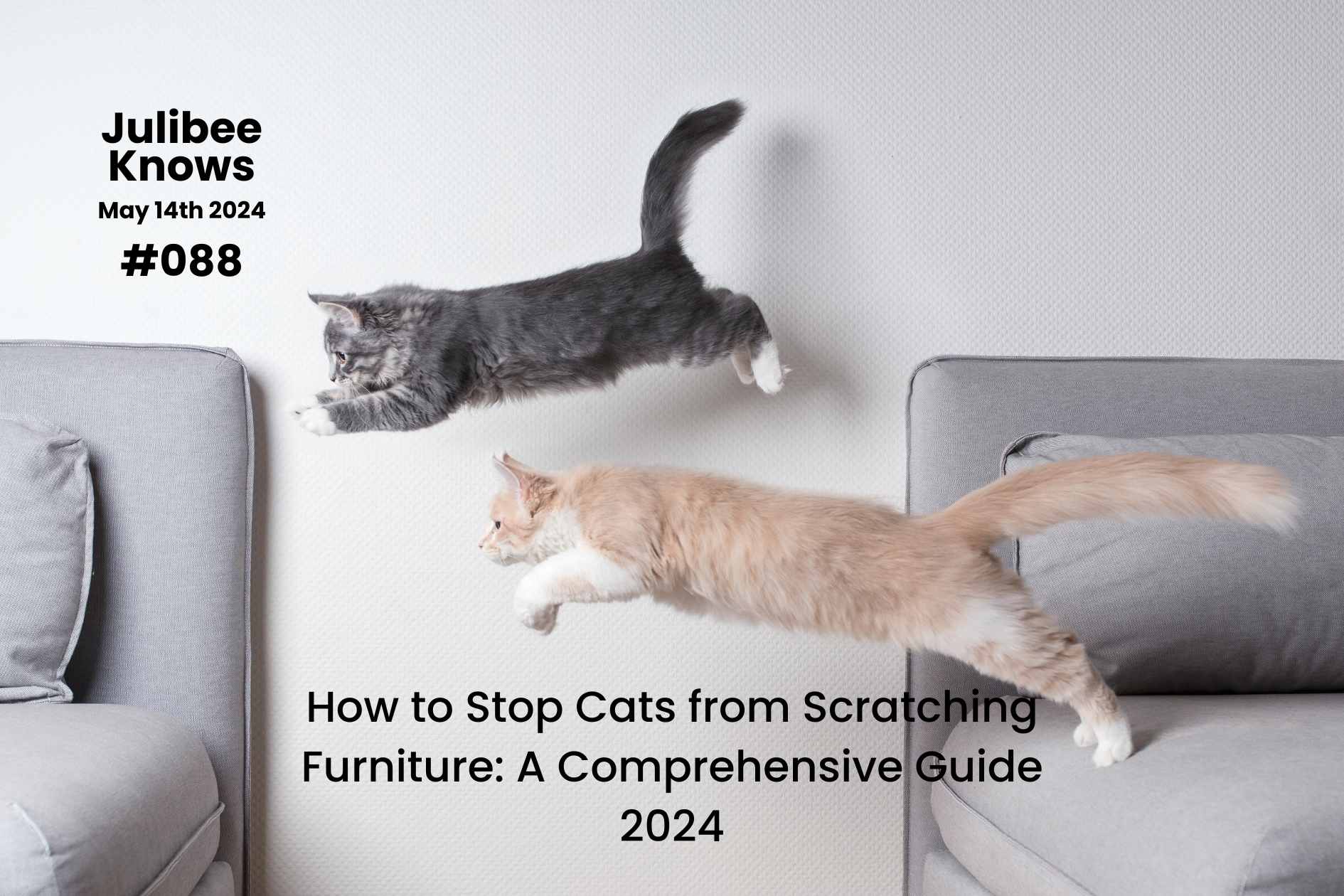
How to Stop Cats from Scratching Furniture: A Comprehensive Guide 2024
Is your cat a furniture shredder? Learn why cats scratch & discover effective ways to stop them! Explore scratching post tips, deterrents, and positive reinforcement methods for a purrfect solution.
Inside this Article:
Cats are known for their playful antics and affectionate nature, but their tendency to scratch furniture can be a major headache for pet owners. This behavior not only damages furniture but can also spread germs and make your home look untidy.
In this comprehensive guide, we will delve into the reasons behind cats' scratching habits and explore effective strategies to prevent this behavior. By understanding your feline friend's motivations and implementing the right measures, you can create a harmonious living environment where both you and your cat can thrive.

Understanding the Why Behind Scratching
Scratching is an innate behavior deeply rooted in a cat's biology. It serves several essential purposes, including:
-
Marking Territory: Cats have scent glands on their paws that release pheromones when they scratch. These pheromones act as territorial markers, communicating their presence to other cats.
-
Sharpening Claws: Cats' claws are constantly growing, and scratching helps them shed old layers and maintain sharp, pointed claws for hunting and self-defense.
-
Stress Relief: Scratching can be a way for cats to relieve stress and anxiety. The physical act of scratching can release endorphins, providing a sense of calm and well-being.
-
Stretching and Exercise: Scratching involves stretching and flexing various muscle groups, promoting overall flexibility and physical fitness.
Identifying Scratching Preferences
Cats often have specific preferences for the surfaces they scratch. Understanding these preferences is crucial for effective prevention.
-
Vertical Surfaces: Cats often prefer scratching vertical surfaces, such as furniture legs, door frames, and curtains.
-
Horizontal Surfaces: Some cats may prefer scratching horizontal surfaces, such as carpets, rugs, or floors.
Prevention Strategies: Providing Alternatives and Discouraging Target Areas
The key to preventing cats from scratching furniture lies in providing them with acceptable alternatives and making target areas less appealing.
1. Offer Appealing Scratching Posts:
-
Material: Choose scratching posts made from materials similar to those your cat scratches, such as sisal, carpet, or cardboard.
-
Placement: Place scratching posts in areas where your cat likes to scratch, such as near furniture, doorways, or windows.
-
Variety: Offer a variety of scratching post styles, including vertical and horizontal options, to cater to your cat's preferences.
2. Enhance Attractiveness:
-
Catnip: Sprinkle catnip on scratching posts to entice your cat to use them.
-
Rewards: Reward your cat with treats or praise when they use the scratching posts.
3. Discourage Target Areas:
-
Double-Sided Tape: Apply double-sided tape to furniture surfaces that your cat likes to scratch. The sticky sensation will deter them from using these areas.
-
Citric Sprays: Use citrus-based sprays, which cats find unpleasant, on furniture legs or other target areas.
-
Coverings: Cover furniture with blankets or throws when not in use to make it less appealing for scratching.

Additional Tips:
-
Regular Nail Trimming: Trim your cat's nails regularly to reduce the damage they can cause when scratching.
-
Provide Enrichment: Ensure your cat has plenty of toys, climbing structures, and interactive activities to keep them entertained and reduce boredom-related scratching.
-
Patience and Consistency: Be patient and consistent with your prevention efforts. It may take time for your cat to adjust to the new scratching options and associate them with the desired behavior.
Unacceptable Practices to Avoid
While deterring scratching is essential, some methods should be avoided due to their negative impact on your cat's well-being:
-
Declawing: Declawing, also known as onychectomy, involves surgically removing the claws of a cat. This procedure is not only painful but can also lead to behavioral and health problems.
-
Punishment: Punishing your cat for scratching will only cause fear and anxiety, potentially exacerbating the problem.
-
Forced Use of Scratching Posts: Forcing your cat to use scratching posts can create negative associations and make them less likely to use them voluntarily.
Conclusion
Understanding your cat's natural scratching behavior and implementing effective prevention strategies can help you create a harmonious home environment where both you and your feline companion can enjoy a peaceful and comfortable coexistence. By providing appealing scratching alternatives, discouraging target areas, and practicing patience and positive reinforcement, you can successfully redirect your cat's scratching instincts and protect your furniture from damage. Remember, a happy and content cat is less likely to engage in destructive scratching behaviors.
References:
-
American Society for the Prevention of Cruelty to Animals (ASPCA): https://www.biglots.com/product/wave-cat-scratcher-with-catnip/p810570195


241 comments
Simply want to say yiur article is aas astonishing.
The clarity in your publish is simply excellent and tat i could think you are a
profgessional onn tthis subject. Fine aong with your permission let me to
grab your feed to stay up to date with coming near
near post. Thank you 1,000,000 and please continue the rewarding work. https://www.waste-Ndc.pro/community/profile/tressa79906983/